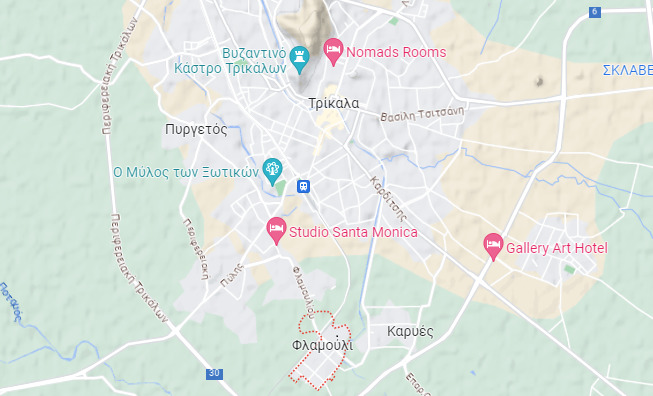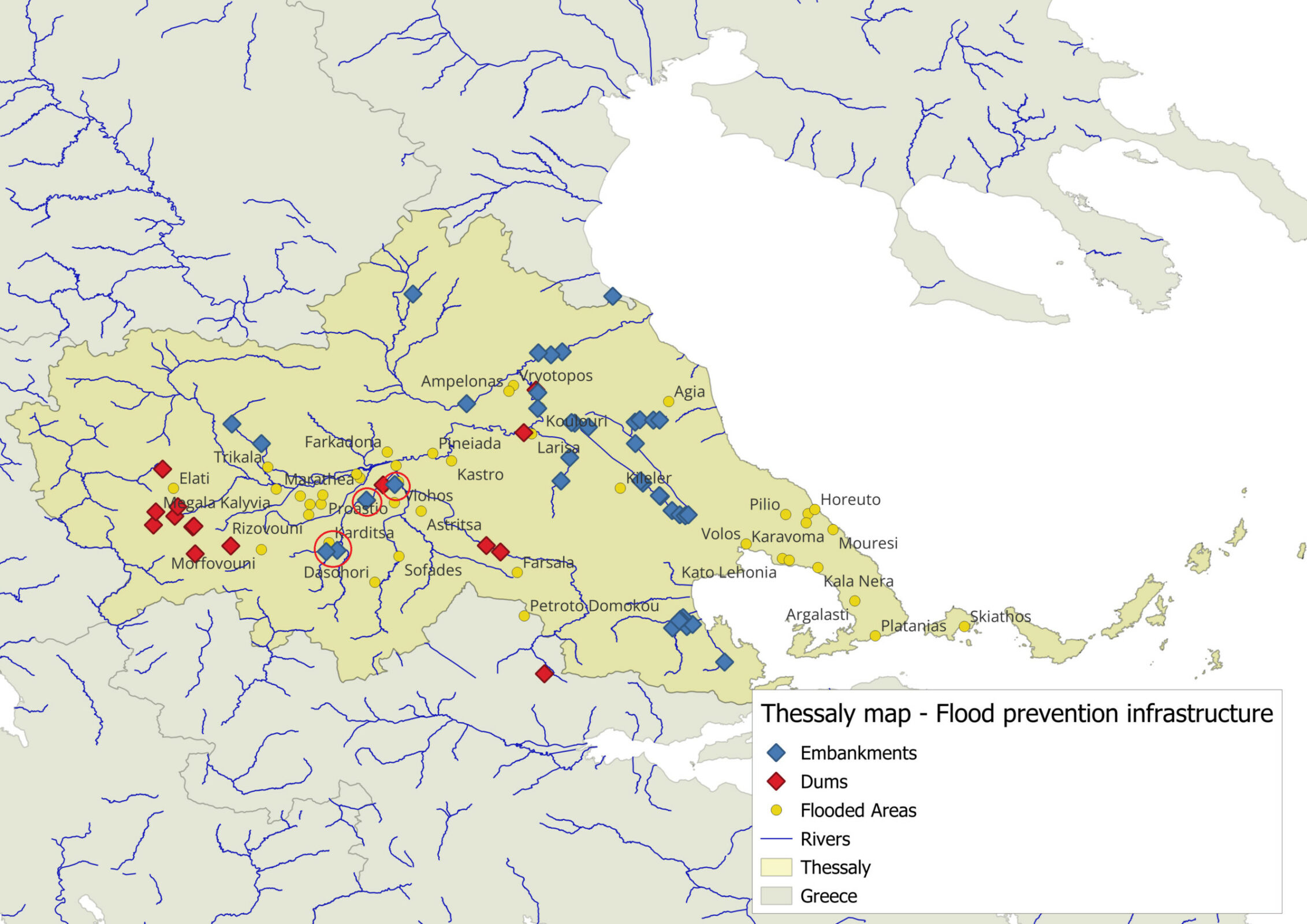Proper planning of flood protection projects, equipping the country with state-of-the-art technology for monitoring meteorological phenomena and studying other climate events, such as drought, related to the climate crisis, are “key” to mitigating the impacts of Daniel and Elias-type events.
Exploring Greece’s Drought Phenomenon: Fires, Floods, and a Parched Landscape

In Greece, drought periods have increased in the past 30 years.
Aggeliki Oikonomou’s mobile phone screen reveals a poignant scene: two individuals are engulfed by water. The video that was shared with iMEdD was recorded by her cousin on the day of the Thessaly floods, which occurred on September 7. In the footage, a man, immersed up to his waist in water, steers a white wooden plank using a rope. On this floating plank, Aggeliki’s 13-year-old cousin can be seen. With one hand, he is attempting to retrieve scattered objects carried away by the swift current. Meanwhile, with his other hand, he clings to the railing of his yard, in an effort to remain anchored against the force of the water.
Aggeliki’s family hails from Flamouli, a small village just minutes away from Trikala. While she resides in Athens throughout the year, she returns each summer to her homeland to spend time with her family. Tragically, her cousins’ home was among those inundated due to the heavy rain. That fateful night, her relatives were forced to take refuge on the rooftop. The storm, named Daniel, wrought havoc upon Trikala, Zagora, and Volos, while the flooded regions extended to cover 4,750 acres. The inundation persisted for an entire week.

To prevent flooding we need to consider drought
Giannis Stamatakis, a meteorologist and the founder of the website forecastweather.gr, reported that the rainfall totalled 200 to 300 mm within a span of roughly 13 to 14 hours. Typically, this region receives such volumes of rain over a period of five to six days. According to the Hellenic National Meteorological Service (EMY), recorded rainfall figures in Trikala, Pertouli, and Kalabaka reached 410, 367, and 356 millimetres, respectively. Notably, these areas serve as the headwaters of the Pinios river, which traverses the entire region of Thessaly and finds its course in the Larissa area.
However, in 2021, the Pineios river was completely dry. Dr. Nikitas Mylopoulos, a professor within the Department of Civil Engineering at the University of Thessaly and the director of the Laboratory of Hydrology and Aquatic Systems Analysis, offers an explanation for why, just a few years later, the river is experiencing an overflow. He says, “River systems, much like the entire natural environment, exhibit extremes. Periods of flooding are followed by droughts, representing prolonged spans with either an absence of water or a scarcity of rain. The interconnection between droughts and floods exemplifies these extreme events, which are increasingly common due to the climate crisis. During the summer months, the Pineios river has started to parch, resulting in its complete lack of water”.
This is a component of the larger mechanism, and it should have the alarm bells going off. If such drought occurrences become more common, we should anticipate more severe instances of flooding.
Dr. Nikitas Mylopoulos, a professor within the Department of Civil Engineering at the University of Thessaly
As evident from the iMEdD drought survey, the past two years have seen a decline in rainfall in Thessaly, a region renowned for its regular and substantial precipitation. In the opinion piece by Prodromos Zanis, Professor of Meteorology and Climatology at the Department of Geology of the Aristotle University of Thessaloniki, on the occasion of the SNF Dialogues entitled “Climate Change – Part 2” it is written: “Climate change is already affecting every inhabited area around the world, with human influence making extreme climate events, including heat waves, heavy rainfall and droughts, more frequent and intense”.
According to a PBS article, “A warmer atmosphere increases the rate at which water evaporates during dry periods, holding more water vapor, which fuels heavy rainfall. “Meanwhile, the European Geosciences Union report, as cited in the Wired article, notes that forest soils with a history of drought do not absorb water as readily. “Anything that sweeps through the ground – whether it’s a drought-fueled fire or a flood that uproots trees from the ground – will make future floods more likely”, is written in the publication.
Dr. Mylopoulos comments, “This is a component of the larger mechanism, and it should have the alarm bells going off. If such drought occurrences become more common, we should anticipate more severe instances of flooding. Because the environment works holistically and has a domino logic, a vicious cycle is created. During a flood, rainfall intensifies, while droughts persist for longer periods. This is the impact of the climate crisis. This is what we’re facing right now, particularly within the Mediterranean region”.

“There needs to be sufficient time to save human lives”
Aggeliki’s family felt prepared. Upon observing the rain’s escalating intensity, they decided to gather some of their belongings and moved them to the first floor of their house. Their residence was already submerged when the 112 emergency alert – coming from the European Union’s emergency service line – sounded on their mobile phones.
To confront the changing circumstances, the nation must equip itself technologically. Meteorological stations play a pivotal role due to their capability to record adverse weather data, as Stamatakis explains to iMEdD. The data gathered from these stations proves invaluable, aiding meteorologists in forecasting how a particular phenomenon will impact a region, considering its unique structure and characteristics. When faced with the dangers posed by severe weather events, this translates into early warnings that enable the timely evacuation of affected areas.
In 2004, ahead of the Olympic Games, eight weather radars were planned, but most of them stopped working due to poor maintenance. The current number is not sufficient for the entire Greek territory.
Regarding the provision of timely warnings, the meteorologist is placing increased emphasis on weather radars. “A weather station provides data every minute, or every two minutes, depending on its recording capacity and maintenance. However, a weather radar offers a per-second update on the movement of a storm and predicts where the storm will impact in the next half-hour”, explains Giannis Stamatakis. According to Thodoris Kolydas, the director of EMY, Greece currently operates two active weather radars, located in Larissa and Andravida, and one partially operational in Aktion. In 2004, ahead of the Olympic Games, eight were planned, but most of them stopped working due to poor maintenance. The current number is not sufficient for the entire Greek territory. Nevertheless, these radars do not offer complete coverage for the entirety of Greece. Stamatakis points out that comprehensive coverage is achieved through data-sharing with neighbouring countries such as Turkey and Bulgaria.

The solution lies in infrastructure
Aggeliki’s family has since returned to their home. They have managed to clean everything, replace their mattresses and are trying to restore a sense of normality. However, the heavy rains caused by Storm “Elias” on September 24, 2023, have once more transformed Volos into a waterlogged region. Τhe embankments on the Enipeas, a tributary of Pineios river, had not had time to be restored after their breach in early September.
Εmbankments are typically positioned along tributaries to contain water and debris in the event of flooding. However, as reported by News247, in Greece, these embankments are frequently “breached” to divert water streams. This redirection practice is widespread and forms an integral aspect of a comprehensive flood control plan.
We cannot solely attribute (this disaster) to the intensity of the phenomenon, although it was indeed formidable and frightening. With proper safeguards in place, we could have mitigated the damage.
Dr. Nikitas Mylopoulos, Professor at the Department of Civil Engineering at the University of Thessaly
This plan encompasses several significant projects, including small dams, dikes, and large dams. As Dr. Mylopoulos explains, each structure is strategically positioned along tributaries and rivers with the purpose of either retaining water or facilitating its redirection to “diversion basins” – locations naturally inclined for water flow. Small dams are situated in mountainous areas at higher altitudes, well before the forceful water flow begins. Embankments, on the other hand, are placed at lower elevations and, if constructed effectively, feature openings, or gates, that can be opened and closed at will. This design enables the controlled ‘channeling’ of water into catchment areas without jeopardising the entire structure and ensures the safety of residents in these regions.
Stamatakis further emphasises that a functional flood control plan necessitates the presence of water sensors in rivers. These sensors provide data on water volume, the specific pathways it follows, and the capacity of each river before it overflows. When coupled with regular weather reports issued every 6 hours and collaborative efforts between meteorologists and civil protection authorities, the impact of such events can be mitigated.
“The climate crisis is undeniably playing a significant role in the heightened frequency of extreme events. Medicane Ianos, which occurred three years ago, and the current Storm Daniel were considered exceedingly rare until just two decades ago. We now need to acknowledge that they are no longer so infrequent”, says Dr. Nikitas Mylopoulos. He underscores that, as these phenomena become more frequent and severe, it is imperative to safeguard regions like those in Thessaly. “We cannot solely attribute (this disaster) to the intensity of the phenomenon, although it was indeed formidable and frightening. With proper safeguards in place, we could have mitigated the damage. I am preparing for floods with specific characteristics, not limited to Daniel, so that when such events occur, we can mitigate their impact. ‘Mitigation’ is the term we should emphasise”.
